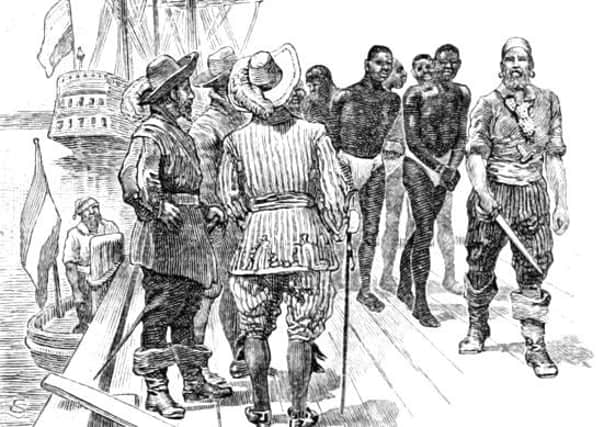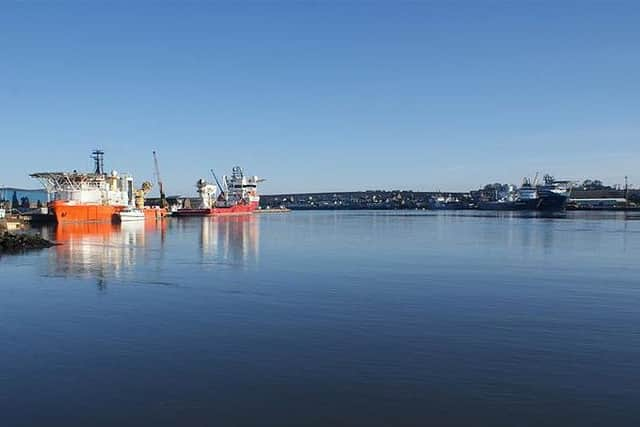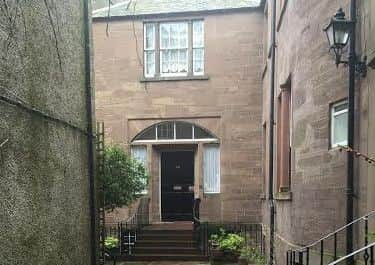Scotland's slave trade and Montrose's key role


The contract is written in flourishing script on parchment paper, its ink naturally faded since it was signed on July 15 1751. Held in a cabinet at Montrose Museum, the document is part of a display on the harbour town’s tobacco trade, which includes a collection of smoking tools, such as clay pipes and little silver storage boxes.
But look closer at the contract and it is actually a deal brokered by a local merchant and shipowner for the purchase and transportation of slaves.
Advertisement
Hide AdAdvertisement
Hide AdIt is a deal between merchants Thomas Douglas and Co and Thomas Gibson, master of the firm’s ship Potomack, who were to sail from Montrose to Newcastle then to Holland to pick up cargo before heading to the Coast of Africa.


“And there sell, barter or otherways dispose upon the said loading. And with the proceeds thereof to Purchase a Cargo of Slaves and Ivory and What Number of Slaves he can purchase.
“And therewith to sail for the West Indies, or Some of His Majesty’s Colonies in Americas, according to the directions he will thereafter receive,” the contract states.
It is a vital window into the trade less associated with the quiet coastal town than its counterparts in the West, such as Port Glasgow and Greenock.


Separate records show that the Potomack did indeed make the journey from Montrose, leaving in October that year.


It headed to Bonny, a stretch of coast on the west of Africa which stretches through Nigeria, Gabon, Equatorial Guinea and Cameroon, under Captains Gibson and Richard Hartley, with 22 crew on board.
At Bonny, records show that 260 slaves were purchased but on arrival in Virginia, 69 of them did not disembark, presumably having not survived the journey.
Advertisement
Hide AdAdvertisement
Hide AdResearch by academic Mark Duffill also found that the Potomack sailing was one of four voyages made from Montrose with direct links to slavery made.
This compare to 19 voyages made from Port Glasgow and Greenock over the same period.


However, the records nevertheless document the transportation of 1,000 men women and children enslaved to plantation owners on boats dispatched from Montrose and illuminate the small coastal town’s involvement in the global trade.
The vessel “Success” left Montrose under Captain James Renny in 1735 before transporting 293 slaves from Africa to the Caribbean. Only 239 slaves disembarked, according to Duffill’s research.
In 1753, tobacco merchants T Douglas and Co sent its ship St George to Africa via Campveersin the Netherlands. It is estimated that 225 to 250 slaves were put on the ship with just 175 to 200 disembarking.
The company made a voyage the following year and sent the “Delight” to Gambia via Holland under the captainship of J. Elphinstone. It is estimated that up to 175 slaves were taken from African with 100 to 150 landing in Virginia.
While these four records exist, information at Montrose Museum estimates that 31 vessels registered to Montrose were involved in the trade.
Advertisement
Hide AdAdvertisement
Hide AdIt was common for Scots and UK merchants to establish their own plantations overseas or create relationships with agreed suppliers for plantation goods.
One renowned family in Montrose during the 1700s wer the Coutts, the founders of the famous Coutts Bank, which includes the Royal Family as customers.
John Coutts, a former five-times Lord Provost of the town between 1677 and 1688 and timber trader, later moved to Edinburgh to set up a counting house but had seven sons and four daughters while in the North East.
While there is no record of any involvement with the ships heading from Montrose, the late Lady Edna Healey, wife of former Chancellor Dennis Healey, wrote in her book Coutts and Co 1692-1992, a Portrait of a Private Bank, that one of the Coutts’ sons Robert, emigrated to Virginia “to be the family representatives in their highly profitable tobacco business.”
She addded: “There were some Montrose merchants who also took ‘black ivory’ from the African coast to the tobacco plantations of Virginia, although the lucrative slave trade was best forgotten.”
Plantation owners from the Montrose area included James Cruikshank of Langley Park, on the outskirts of the town, who owned half of Richmond, Mirton and Greenhill estates in St Vincent, Jamaica, with his brother Patrick.
Patrick, formerly of Glenskinno near Hillside, was later to be compensated £23,000 by the UK government for loss of “property” following the abolition of slavery in 1833. He had more than 800 slaves on his estates.
Advertisement
Hide AdAdvertisement
Hide AdMeanwhile, records also show that a Mary Russell, listed to a Bellvue Cottage, Montrose, unsuccessfully claimed for compensation for 27 slaves held at the Plaisance Estate on Dominica.
Duffill described Scots involvement in the slave trade as “experimental” with “no great eagerness” to rush into the business.
However, he also notes that, between 1709 and 1711, merchants from Montrose along with those from Glasgow, Edinburgh, Aberdeen, Dundee and Inverness petitioned the UK parliament on eight separate occasions against proposals to restore the Royal African Company the monopoly of trade on the west coast of Africa .
The petitioners argued that such a move would infringe the terms of the Act of Union and its guarantee that all subjects would have full trade freedom. The merchants were successful in their pleas.